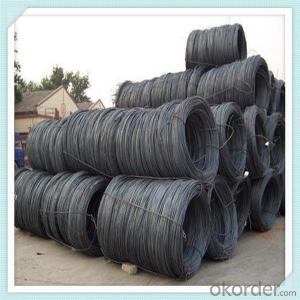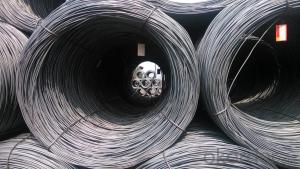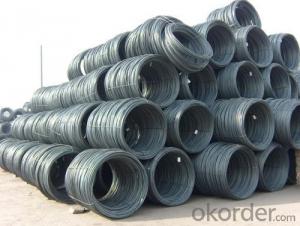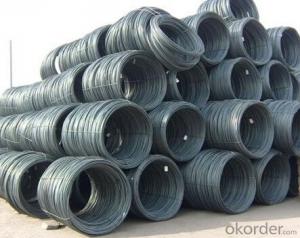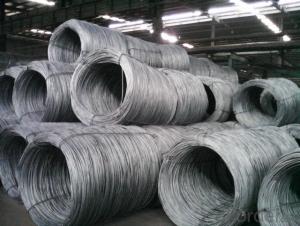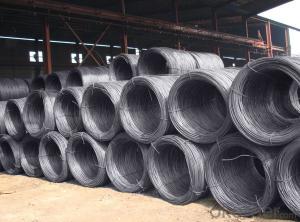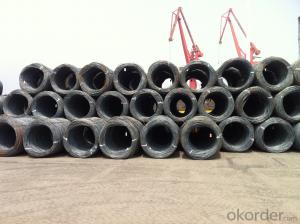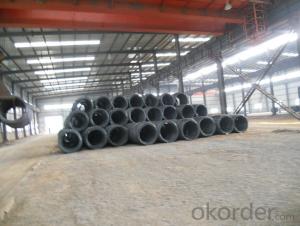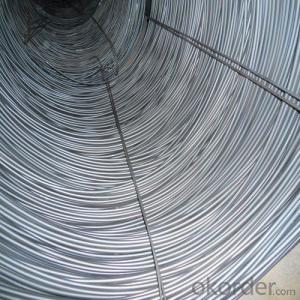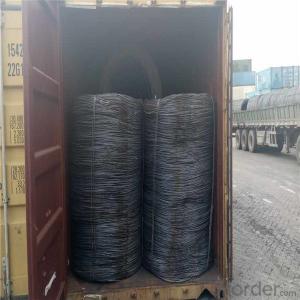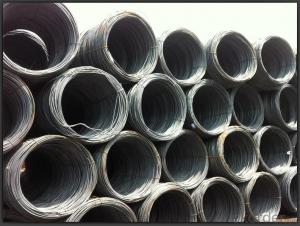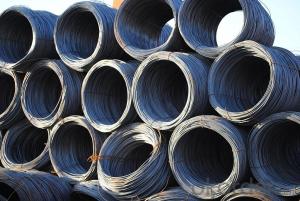SAE1008B Steel wire rod hot rolled low carbon
- Loading Port:
- Tianjin
- Payment Terms:
- TT OR LC
- Min Order Qty:
- 100 m.t.
- Supply Capability:
- 12532 m.t./month
OKorder Service Pledge
OKorder Financial Service
You Might Also Like
Specification
Features
1、Pure steel quality, stable chemical contents, small tolerance.
2、Constant Quality, good drawing performance.
3、High dimension accuracy degree, accuracy degree of Level C up to 80%, smooth surface, less scale,
easy to be pickled.
4、Automatic bundling with 4 lines by Machine in tidy and good looks
5、Big high quality percentage, small coil percentage, and heavy coil weight for Hard Coil.
6、High sorbitizing percentage.
Produced from billets at the rolling mill, wire rod is the basis of all steel wire, rope and fencing products.
The most important characteristic in determining wire rod’s end use is its drawability. Common low carbon
wire rod is used for nails, small shaped products, barbed wires, various wire nettings, steel chains, and
other applications. High Carbon wire rod uses include steel tire cords for automobiles, conveyor belts,
and pressure hoses. Other applications include bolts, nuts, and machine parts, as well as compression,
tension and torsion springs
Product Description :
Standard | AISI, ASTM, BS, DIN, GB, JIS |
Material/steel grade | Q195-Q235,SAE1006B,SAE1006CR, SAE1008B, SAE1008CR, SAE1010B, SAE1018B, or according to customers requirements |
Wire Gauge | 5.5-12mm |
Coil weight | 1.8-2.1mts |
MOQ | 25MT |
Delivery Time | 15-30 days after receipt of L/C or deposit by T/T |
Packing | In coil and load in container, if large quantity, by bulk vessel; Can be packed as customers' special requirements |
Payment terms | 1).100% irrevocable L/C at sight. 2).30% T/T prepaid and the balance against the copy of B/L. 3).30% T/T prepaid and the balance against L/C |
Application | widely used in machinery parts, manufacturing industry, electronics industry, metal tools and others |
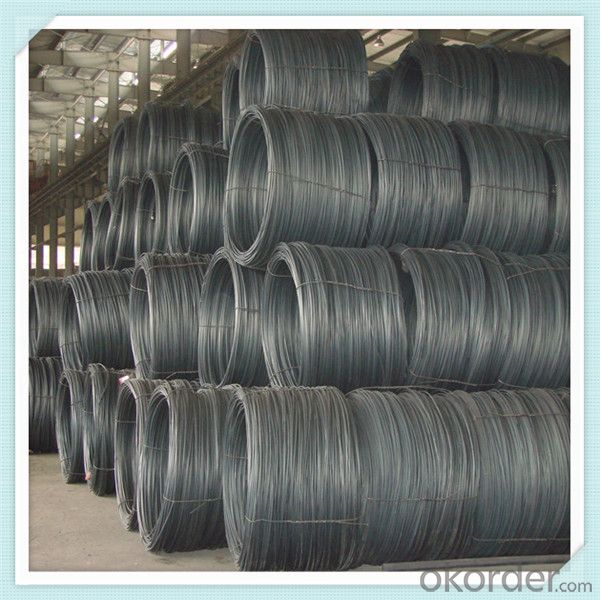
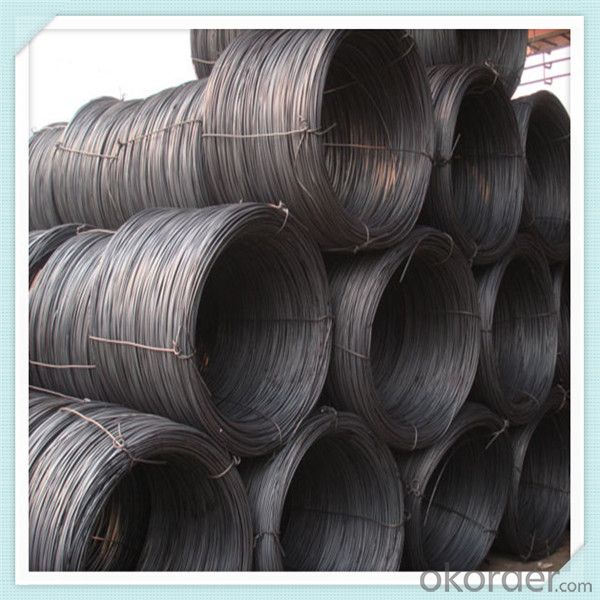
Application :
It generally used in braiding the hose for bathing product and machinery. With it
good flexibility, resistant to high temperature and resistant to corrosion, it
used widely in many industries.
Packing :
Hot-rolled wire rod is held in a unit with at least four steel straps in the
transverse direction and transported and stored without further packaging.
Before
the steel strapping is applied, the wire rod must be sufficiently compressed.
The strapping is fixed in the transverse direction with a single circumferential
strap so that the strapping does not slip and cause the coil to come apart.
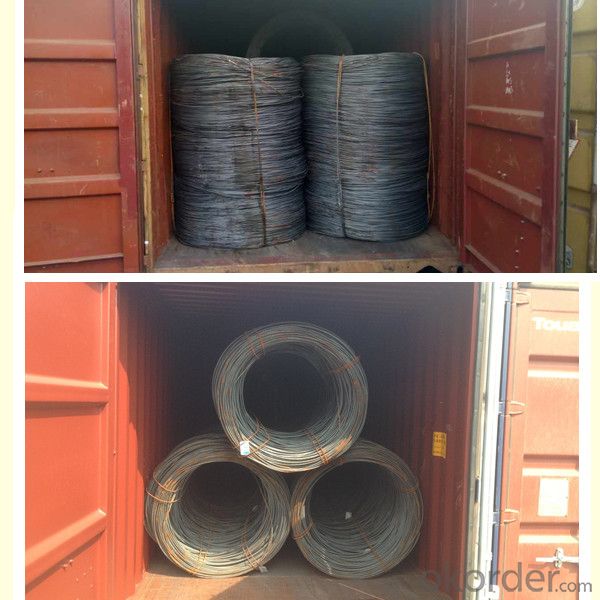
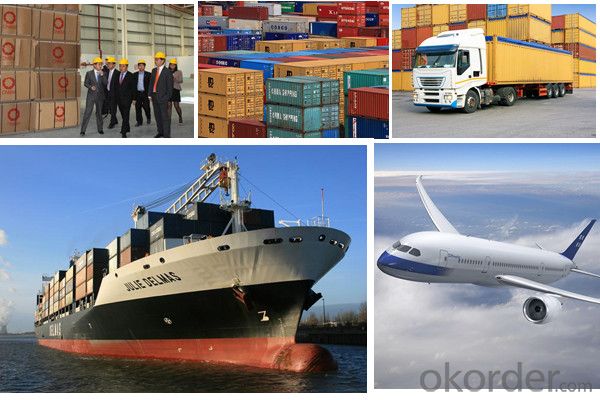
Our service:
(1) We cooperate with famous factories with advanced equipment and well trained workers.
(2) We can provide factory price with trading company service.
(3) We continuously work on the improvement of our processes, guaranteeing
consistently high standards of quality to keep none compensation.
(4) We guarantee 24 hours response and 48 hours solution providing service.
(5) We accept small order quantity before formal cooperation.
(6) We deliver the agreed quality at the agreed time, reacting to changes in
customer wishes in a flexible way.
(7) Due to our volume and selling power, we have excellent freight rates with
shipping lines.
(8) We strive to always be fair and honest in our dealings with customers.
(9) We strive to work together with customers to achieve much more than we can
achieve alone.
(10) Through our passion and commitment we aim to be a market leader in all our
key markets. To maintain our position as market leader we must continue to add
value in all that we do.
FAQ:
1.Q: What's your MOQ(minimum order quantity)?
A: One full container, mixed acceptable .
2. Q: What's your packing methods?
A: Packed in bundle or bulk ..
3. Q: How can I buy CNBM products in my country?
A:Please send us an inquiry or email ,we will reply to you if there is distributor in your country
4. Q: Can we visit your factory?
A: Warmly welcome. Once we have your schedule, we will arrange the
professional sales team to follow up your case.
5. Q: How long does it take to get the product if i place an order?
A:With the process of your requirements,we will pack and deliver in 3
-7 days. If it is by sea shipment,it will take 15-45 days depending on different locations
- Q: What are the different corrosion testing methods for steel wire rod?
- There are several corrosion testing methods for steel wire rod, including salt spray testing, exposure testing in natural environments, electrochemical testing, and accelerated corrosion testing using corrosive liquids or gases. These methods help assess the corrosion resistance and durability of the steel wire rod in various conditions.
- Q: How are steel wire rods used in the manufacturing of mesh screens for filtration and separation?
- Steel wire rods are used in the manufacturing of mesh screens for filtration and separation by being woven together to form a strong and durable mesh structure. These rods provide the necessary strength and rigidity to support the mesh and ensure it can withstand the pressure and demands of the filtration and separation processes.
- Q: How is steel wire rod used in the manufacturing of wire forms for medical devices?
- Steel wire rod is an indispensable element in the production of wire forms for medical devices. It acts as the raw material that is processed and converted into different wire forms used for medical purposes. To begin with, the steel wire rod undergoes a series of procedures such as drawing, annealing, and coating to enhance its properties and make it suitable for medical device applications. Drawing entails reducing the diameter of the wire rod through a sequence of dies, resulting in a thinner and more flexible wire. Annealing is a heat treatment process that improves the wire's ductility and eliminates any residual stresses. Coating, such as electroplating or passivation, is applied to the wire to provide corrosion resistance and enhance biocompatibility. Once the steel wire rod is processed, it can be utilized in the manufacturing of a wide range of wire forms for medical devices. These wire forms include springs, coils, guidewires, catheters, and various surgical instruments. Springs made from steel wire rod are utilized in devices like implantable cardiac pacemakers, where they offer mechanical support and aid in regulating the heart's rhythm. Coils and guidewires made from steel wire rod are used in minimally invasive procedures, such as stenting or catheterization, where they provide flexibility and maneuverability to navigate through blood vessels or other body structures. The high strength and durability of steel wire rod make it suitable for applications where reliability and precision are crucial, such as orthopedic implants or surgical instruments. It can be shaped into intricate forms and sizes, allowing for the production of customized wire forms that meet the specific requirements of different medical devices. Furthermore, steel wire rod's biocompatibility, when appropriately coated or treated, ensures that it does not have any adverse reactions with the human body, making it safe for use in medical applications. In conclusion, steel wire rod plays a vital role in the production of wire forms for medical devices. Through various processing techniques, it is transformed into springs, coils, guidewires, and other wire forms that provide mechanical support, flexibility, and precision in medical applications. The strength, durability, and biocompatibility of steel wire rod make it an excellent choice for the production of wire forms used in medical devices.
- Q: What are the different surface finishes available for steel wire rod?
- Some of the different surface finishes available for steel wire rod include black, pickled and oiled, galvanized, and coated with various types of finishes such as epoxy or zinc.
- Q: How is the steel wire rod market expected to grow in the future?
- The steel wire rod market is expected to grow significantly in the future due to several key factors. Firstly, the increasing demand for steel wire rods in various industries such as construction, automotive, and manufacturing is expected to drive market growth. Steel wire rods are essential for applications such as reinforcement in concrete structures, wire mesh for fencing, and manufacturing of automobile parts. Additionally, the rising urbanization and industrialization in developing economies are likely to fuel the demand for steel wire rods. As these countries continue to invest in infrastructure development and construction projects, the need for steel wire rods will grow substantially. Moreover, the automotive industry's shift towards electric vehicles and lightweight materials is expected to further boost the demand for steel wire rods as they are crucial for producing lightweight yet strong components. Furthermore, advancements in technology and innovation in steel manufacturing processes are anticipated to positively impact the market growth. These advancements allow for the production of high-quality steel wire rods that meet the specific requirements of various industries. Additionally, the implementation of stringent safety and quality standards by regulatory bodies is expected to drive the demand for premium-grade steel wire rods. Moreover, the growing focus on sustainable and eco-friendly construction practices is likely to contribute to market growth. Steel wire rods are recyclable, making them a preferred choice in environmentally conscious projects. Furthermore, the increasing adoption of steel wire rods in the renewable energy sector, particularly wind energy, is expected to create new growth opportunities for the market. In conclusion, the steel wire rod market is expected to witness significant growth in the future, driven by increasing demand from various industries, urbanization, technological advancements, and the focus on sustainable practices.
- Q: How is steel wire rod tested for internal defects?
- Non-destructive testing (NDT) is commonly used to examine steel wire rod for internal defects. Various techniques are employed to detect and evaluate these flaws. Ultrasonic testing (UT) is a frequently utilized method that employs high-frequency sound waves to identify internal flaws. Ultrasonic waves are emitted by a transducer into the wire rod and any internal defects cause the waves to reflect back. The reflected waves are then analyzed to determine the defects' size, shape, and location. Another technique is eddy current testing (ECT), which utilizes electromagnetic induction to identify surface and near-surface defects. By passing an alternating current-carrying coil over the wire rod, any variations in electrical conductivity caused by flaws are detected. This method is particularly effective for detecting surface-related flaws like cracks. Magnetic particle testing (MPT) is also commonly employed. It involves magnetizing the wire rod and then applying iron particles to its surface. These particles accumulate around areas with internal defects, making them easily visible to inspectors. Furthermore, dye penetrant testing (DPT) can be utilized to detect surface-breaking defects. This method involves applying liquid dye to the rod's surface, which seeps into any cracks or openings. After a certain period, excess dye is removed and a developer is applied to make the defects visible. In conclusion, non-destructive testing techniques like ultrasonic testing, eddy current testing, magnetic particle testing, and dye penetrant testing allow for the identification and evaluation of internal and surface defects in steel wire rod without causing damage.
- Q: How is steel wire rod used in the manufacturing of wire for automotive airbags?
- Steel wire rod is an essential component in the manufacturing process of wire for automotive airbags. The wire rod serves as the raw material that is transformed into the final wire used in the airbag system. Firstly, the steel wire rod goes through a series of processes to enhance its properties and make it suitable for airbag wire manufacturing. These processes include cleaning, heating, and shaping the rod into the desired diameter and shape. The rod may also undergo surface treatments to improve its corrosion resistance and strength. Once the rod is prepared, it is then drawn through a series of dies to reduce its diameter and increase its length. This process, known as wire drawing, significantly improves the wire's strength and flexibility. The wire is typically drawn several times to achieve the required diameter and mechanical properties. After the wire drawing process, the wire is further processed to ensure it meets the specific requirements of automotive airbags. It may undergo additional heat treatments to enhance its strength and ductility, making it capable of withstanding the forces exerted during airbag deployment. The final wire produced from the steel wire rod is then used in the fabrication of the airbag system. The wire is typically woven or knitted to form a strong and flexible fabric that can expand rapidly upon airbag deployment. This fabric is then incorporated into the airbag module, which also includes other components such as the inflator and cushion. Overall, steel wire rod plays a crucial role in the manufacturing of wire for automotive airbags. It provides the raw material that is processed and transformed into the final wire, which is strong, flexible, and capable of effectively protecting occupants in the event of a collision.
- Q: How are steel wire rods used in the manufacturing of mesh screens?
- Mesh screens rely heavily on steel wire rods as a fundamental ingredient in their production. These rods are typically crafted from top-notch steel, known for its robustness, longevity, and resistance to corrosion. The initial step involves selecting the appropriate grade of steel wire rod, based on the desired specifications for the mesh screen. The steel wire rods undergo a series of processes to prepare them for use. These processes include cleaning, straightening, and cutting, ensuring that the rods are devoid of impurities and possess the correct dimensions. Once the wire rods are prepared, they are fed into a mesh weaving machine. This machine is equipped with multiple weaving heads, which intertwine the wire rods both horizontally and vertically, creating a grid-like structure. The interlacing process can be performed in various patterns, such as plain weave, twill weave, or Dutch weave, depending on the intended application of the mesh screen. Throughout the weaving process, the steel wire rods are tightly woven together, resulting in a mesh that is both sturdy and flexible. This mesh structure offers numerous advantages, including heightened strength, resilience, and resistance to deformation. Following the weaving process, the mesh screens may undergo additional treatments to further enhance their properties. These treatments may involve heat treatment or surface coating, aiming to augment the mesh's resistance to rust, abrasion, or chemical corrosion, depending on the specific requirements of its application. In summary, steel wire rods play a pivotal role in the production of mesh screens by providing the essential material for weaving the mesh structure. The resulting mesh screens find application in diverse industries, such as construction, mining, agriculture, filtration, and security, among others. Their versatility, strength, and durability make them an ideal choice for a wide range of applications.
- Q: What are the main applications of steel wire rod in automotive manufacturing?
- Steel wire rod is widely used in automotive manufacturing for various applications. One of the main uses is in the production of tires, where steel wire rod is used as reinforcement material to enhance the strength and durability of tires. Steel wire rods are also used in the manufacturing of springs, such as suspension springs and seat springs, which provide stability and support to the vehicle. Additionally, steel wire rod is utilized in the production of automotive cables, such as brake cables and clutch cables, due to its high tensile strength and excellent resistance to corrosion. Overall, steel wire rod plays a crucial role in automotive manufacturing by providing essential components that ensure the safety, performance, and reliability of vehicles.
- Q: How is the demand for steel wire rod influenced by global economic trends?
- The demand for steel wire rod is influenced by global economic trends due to its wide range of applications across various industries. When the global economy is thriving, there is typically an increase in construction, manufacturing, and infrastructure projects, leading to a higher demand for steel wire rod. Conversely, during economic downturns, the demand for steel wire rod tends to decrease as industries scale back on their activities. Additionally, global economic trends can also affect the cost of raw materials, transportation, and currency exchange rates, all of which impact the demand for steel wire rod.
Send your message to us
SAE1008B Steel wire rod hot rolled low carbon
- Loading Port:
- Tianjin
- Payment Terms:
- TT OR LC
- Min Order Qty:
- 100 m.t.
- Supply Capability:
- 12532 m.t./month
OKorder Service Pledge
OKorder Financial Service
Similar products
Hot products
Hot Searches
Related keywords
